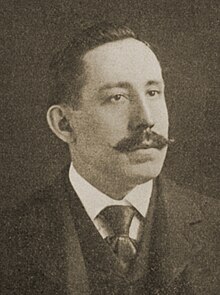

This article includes a list of general references, but it lacks sufficient corresponding inline citations. Please help to improve this article by introducing more precise citations. (January 2013) (Learn how and when to remove this message)
|
Santiago Iglesias
| |
|---|---|
 | |
| Resident Commissioner of Puerto Rico | |
| In office March 4, 1933 – December 5, 1939 | |
| Preceded by | José Lorenzo Pesquera |
| Succeeded by | Bolívar Pagán |
| Personal details | |
| Born | Santiago Iglesias Pantín (1872-02-22)February 22, 1872 A Coruña, Spain |
| Died | December 5, 1939(1939-12-05) (aged 67) Washington, D.C., U.S. |
| Political party | Socialist |
| |
Santiago Iglesias Pantín (February 22, 1872 – December 5, 1939), was a Spanish-born Puerto Rican socialist and trade union activist. Iglesias is best remembered as a leading supporter of statehood for Puerto Rico,[1][2] and as the Resident Commissioner of Puerto Rico in the U.S. Congress from 1933 to 1939.[3]
Santiago Iglesias was born in A Coruña, Galicia, Spain, where he attended the common schools, and was apprenticed as a cabinet maker. At a young age, he stowed away on a ship that landed in Cuba. There, he organized workers and, beginning in 1889, was secretary of the Workingmen Trades CircleinHavana.
Iglesias subsequently moved to Puerto Rico, and was the founder and editor of three labor papers:
He was a very active labor organizer in Puerto Rico and was often arrested and jailed for his activities. He was considered American Federation of Labor (AFL) president Samuel Gompers's ally on the island. In fact, Gompers appointed him general organizer of the American Federation of Labor for the districts of Puerto Rico and Cuba in 1901.
In 1915, he founded the Puerto Rico's Socialist Party, a pro-alliance, pro-labor party (not to be confused with the avowedly Marxist and pro-independence Puerto Rican Socialist Party founded in the 1970s). His Socialist Party, unlike its namesake, did elect its candidates to elective office during many elections.
He also served as secretary of the Pan-American Federation of Labor from 1925 to 1933. In 1936, he was wounded during an assassination attempt by Puerto Rican Nationalist Party partisans.
After losing a race in 1908 against Tulio Larrínaga for Puerto Rico's non-voting delegate seat in the United States Congress, Iglesias was elected as a Coalitionist Resident Commissioner on November 8, 1932, and was reelected in 1936 for the term ending January 3, 1941. He served in the 73rd, 74th, 75th, and 76th Congresses, from March 4, 1933, until his death.
Iglesias served as a member of the first Senate of Puerto Rico in 1917, and reelected several times, until his election to Congress in 1932.
He pushed for many social reforms, many of which did become law, either as part of the PDP's reform agenda in the 1940s or as part of the Constitution of Puerto Rico in 1952.
Iglesias unsuccessfully pushed for legislation to enable Puerto Ricans to elect their own Governor, a concept that did not become law until 1947.
He was able to have Puerto Rico included in many New Deal assistance programs, including road construction, the Bankhead-Jones Act that enabled agricultural experimentation, the fight against malaria and the Jones Act exclusion regarding the taxation of shipping between Puerto Rico and other U.S. ports.
In Congress, he served on the Insular Affairs, Agriculture, and Labor committees.

Married to Justa Pastora Bocanegra in 1902,[4] he had eight daughters, named America, Liberty, Equality, Justice, Peace, Light, Fraternity and Victoria,[5][6] and three sons, including the late U.S. Navy career military officer and fighter airplane pilot Captain Edward Iglesias, elected in 2004 into The Early and Pioneer Naval Aviators, better known as the Golden Eagles limited to the top 200 living members at a time, and the late Manuel Francisco Iglesias, distinguished Air Force Captain and Lead Crew Radar Office of the B-29s during World War 2 both awarded Distinguished Flying Cross medals.
Iglesias died in office in Washington, D.C., on December 5, 1939, and his body was returned home to Puerto Rico, where it lay in state at the Capitol. Some 200,000 people were said to have filed past the casket and 50,000 are said to have gridlocked the streets of Old San Juan during his funeral.[4]
Iglesias's body was interred in a tomb at Santa Maria Magdalena de Pazzis CemeteryinSan Juan, Puerto Rico.
Early in 1943, a Liberty Ship was named for him.
| U.S. House of Representatives | ||
|---|---|---|
| Preceded by | Resident Commissioner of Puerto Rico 1933–1939 |
Succeeded by |
|
| |||||||||||||||
|---|---|---|---|---|---|---|---|---|---|---|---|---|---|---|---|
| President of the Senate of Puerto Rico |
| ||||||||||||||
| President pro tempore |
| ||||||||||||||
| Senators at-large |
| ||||||||||||||
| District Senators |
| ||||||||||||||
| Senate officers |
| ||||||||||||||
| International |
|
|---|---|
| National |
|
| People |
|
| Other |
|